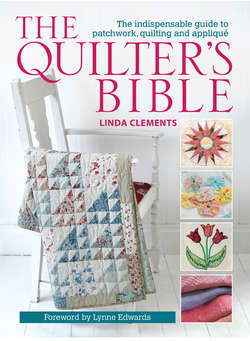Читать книгу The Quilter's Bible - Linda - Страница 42
На сайте Литреса книга снята с продажи.
Marking Fabrics
ОглавлениеDesigns can be transferred or marked on fabric ready for cutting out or quilting in various ways but there are things to consider. Should the marks be permanent or temporary? Can the marks be ironed, or does this set them? How do markers react with different fabrics? To be safe, always test a marking method on scrap fabric.
Select a marker to suit the fabric and its colour. Here a water-soluble pen has been used on the pale fabric, with a white watercolour pencil on the darker fabric. Both markers are easily washed out. A chalk marker would also have been suitable for the darker fabric.
Pencils – Normal graphite pencils and water-soluble coloured pencils can be used for marking. Marks should wash out with laundering. Quilter’s or dressmaker’s pencils are available in various colours. They have a wax content so may not be as easy to remove but should wash out.
Removable marking pens – These include water-soluble, iron-off and air-fading. The sort you choose depends on your project and preference. Some water-soluble markers can be set by the heat of an iron, so care needs to be taken to avoid this. Water-soluble markers can require more than a dab of moisture to remove them. Air-erasable markers may not stay in place long enough to complete a larger project but would work well with quicker projects. As the long-term effects of markers on fabric are not yet known it might be wise to rinse finished projects.
Chalk – This is easy to remove with a soft toothbrush, though take care with pink and blue coloured chalk on very light fabrics. Chalk is available in various colours and forms, including chalk pencils, blocks and as powder distributed through a wheel (Chaco liner). Chalk lines may need to be re-marked on large projects or those that have been handled a lot.
Hera – This plastic or bone tool is great for scoring temporary lines on fabric.
Masking tape – Low-tack masking tape is ideal for marking straight lines for quilting. Stick the tape in position and quilt along the edge of the tape. Remove the tape promptly to avoid stickiness on the fabric.
Compass – This is useful to mark circles. Circles can also be marked using templates cut from card or plastic or by drawing around plates, cups and even the plastic bases from pizzas. Curves can also be marked using a flexicurve.
Tracing – If tracing a design for quilting you will need to do this before layering the quilt into a sandwich in order to be able to see through the fabric. A light box is useful. (see Tracing.)
Dressmaker’s carbon paper – This can be used for tracing or with templates and stencils. Most marks can be removed with washing. Various colours are available to suit different-coloured fabrics. Place the coloured side face down on top of the right side of the fabric and use a hard pencil to draw the design, checking to see it is transferring. You could use a spoked marking wheel instead, which will leave dots rather than a continuous line.
Embroidery transfer marker – This method is suitable for designs that will be cut out or where stitching will obscure the marked line. Draw the design on paper with a pencil. Turn the paper over and draw the design again, following the pencil line with an embroidery transfer marker. Position the design on the right side of the fabric with the marker line down. Use a warm iron to transfer the marked line on to the fabric.
Needle marking – Also called needle tracking, this method temporarily scores the fabric. Place the quilt top on a padded surface so the needle point can be pressed into it. Use the tip of a blunt tapestry needle to score the design on the fabric.
Perforated paper – Perforated paper and chalk powder are used in a technique called pierce and pounce, where chalk is pushed through holes in the paper. It can be used to mark dark fabrics. Draw the quilting design on paper and follow the lines with an unthreaded sewing machine to pierce holes. Place the paper on the fabric, sprinkle chalk over it and use a pad of cottonwool to push the powder through the holes. Use a chalk marker to go over the dotted lines.
Stencils and templates – These are very popular ways to mark designs and quilting patterns – see Using Templates and Marking Designs.
